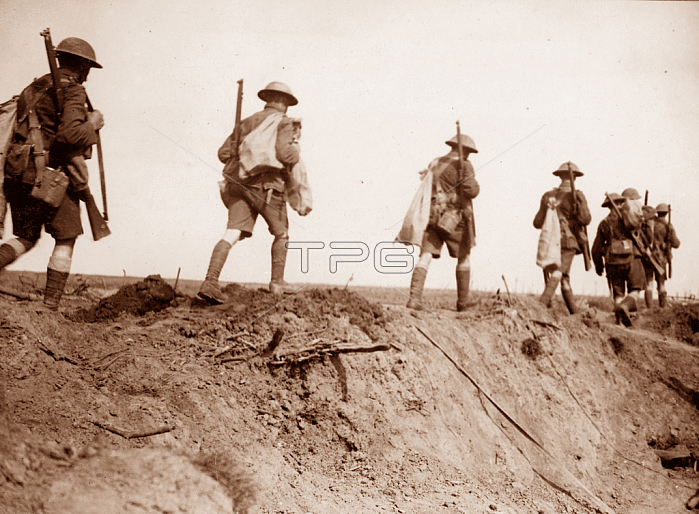
5921659 Battle of Menin Road. North-country troops bring up rations, 1917 (b/w photo) by Unknown photographer, (20th century); National Army Museum, London; (add.info.: Battle of Menin Road: North-country troops bring up rations, 1917. Photograph, World War One, Western Front (1914-1918), 1917. Moving supplies up to the front line trenches was a dangerous business and men carrying food and drink rations were often targeted by enemy snipers. In some sections of the line, supply convoys would vary the times and routes of their journeys in order to maximise their chances of getting through unscathed. A major operation during the Third Battle of Ypres and the drive towards Passchendaele, the Battle of Menin Road (20-25 September 1917) witnessed the first use of General Herbert Plumer?s ?bite and hold? strategy. After repeatedly trying to break through on a wide front and being halted by the deep German defence system, Plumer instead selected a small part of the German front line. This would be heavily shelled and then attacked in strength. The advancing troops would stop once they had penetrated 1,500 yards into the German lines. At this point they would dig in, and another wave of attacking troops would pass through them to attack the next objective. The original attackers would then consolidate the ground they had taken, and become the new reserve for future advances. Using this tactic became possible when more artillery was deployed, thanks partly to the ground drying out between late August and September. Additionally, it was enhanced by using more, better aircraft, carrying out close air support and air defence, contact-patrol, counter-attack patrol, artillery observation and ground-attack. It meant that British soldiers did not move beyond where they could be supported, and consolidated gains made. This meant that when the German counter-attack was launched, instead of finding a mass of exhausted and disorganised men at the limit of the Allied advance, they would find a well organised defensive line still in range of supporting artillery. The Menin Road operation was a success with most of Plumer?s objectives being captured on the first day. German counter-attacks were repulsed the first and second days of the operation. Three quiet days followed. The battle ended with a final German counter-attack on 25 September, again repulsed without serious problems.); by National Army Museum .
| px | px | dpi | = | cm | x | cm | = | MB |
Details
Creative#:
TOP27771334
Source:
達志影像
Authorization Type:
RM
Release Information:
須由TPG 完整授權
Model Release:
No
Property Release:
No
Right to Privacy:
No
Same folder images:

 Loading
Loading